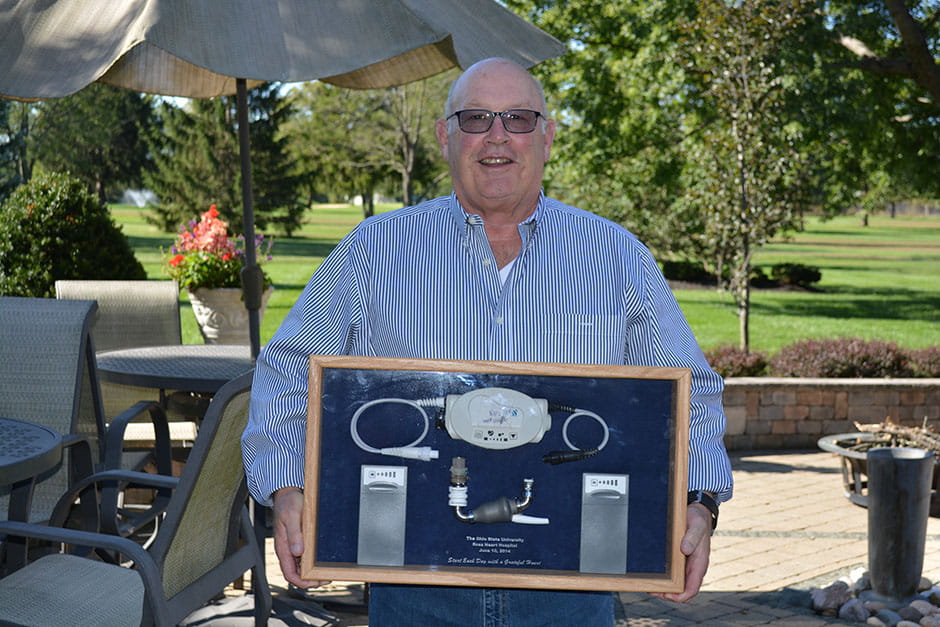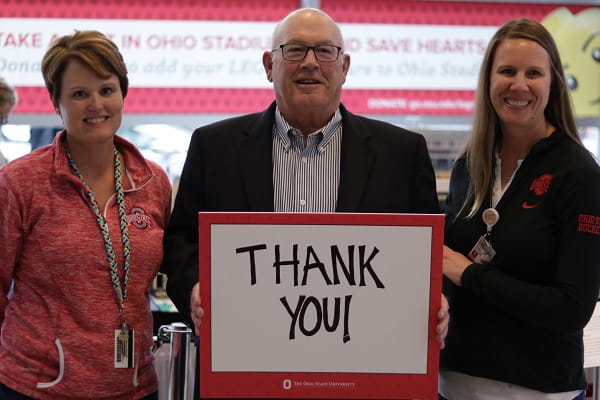Brian Williamson’s tenacity, drive and persistence helped bring him professional success.
When those characteristics threatened to take everything from him, he found help in two places: his family, and The Ohio State University Wexner Medical Center.

Now, five years after the heart transplant that saved his life, Brian is leading an effort to help make sure others find the same outcomes.
The Troy, Ohio, resident started his own steel business in 1982, a time in his life which he now sums up by saying “I was the poster boy for Type A personalities.” He admits he “ate too much, smoked too much and drank too much,” and in 1999 he was diagnosed with congestive heart failure. He was 49.
His treatment at Ohio State began that year, with a pacemaker and a clinical trial. But his health continued to deteriorate until 2012, when his oldest son accompanied him to an appointment. Brian had plans to leave shortly after the appointment on an extended trip to Florida. Those plans came to a halt when his cardiologist, Dr. Garrie Haas, took note of his gray skin and told him he needed to be admitted immediately.
“I said, ‘I’ve got a big event coming up in three weeks. I’ll be in after that,’” Brian recalls. “He looks at me and he says ‘Oh, you’re gonna have a big event.’”
He had a heart pump installed and qualified for a transplant, which ultimately came in June 2014. He has recently made a significant gift to help fund a project that will allow for Ohio State to receive more hearts for transplantation.
The Organ Care System, created by Transmedics, is a perfusion system for organs including the heart. It will allow Ohio State to retrieve hearts for transplant beyond the roughly 1,000-mile radius that is currently deemed safe to transport hearts.
Additionally, the perfusion work being done by Dr. Bryan Whitson, a cardiac surgeon, with the help of this system will allow for additional hearts to become viable for transplant. This research allows Ohio State to rehabilitate hearts that might otherwise have not been suitable for transplant.
This new plan would call for the system to be used to bring five hearts to the Richard M. Ross Heart Hospital for transplantation. Brian’s gift supports it, but additional philanthropy is needed to bring it to fruition.
This is not Brian’s first gift to the Ross – he donated his heart for research at Ohio State’s Human Heart Program, which does more research on live human heart tissue than any program in the world.
The program, led by Paul Janssen, PhD, incorporates 17 labs working together to study human hearts that have been donated. The hearts can be kept beating for up to five days, and the collaborative nature of the labs examining a single human heart can help researchers make better correlations about how different parts of the heart function together. Those kinds of discoveries can lead to breakthroughs in preventing and treating arrhythmia, cardiac disease and heart failure.
Brian also has given to help fund additional research in the Human Heart Program. His donation was made in conjunction with a fundraising campaign that incorporated a replica of Ohio Stadium that Dr. Janssen built out of about 1 million LEGO blocks.
Now 70, Brian says he’s stronger than he’s been in years. He attributes his recovery to the persistence of his family – which includes his girlfriend, Jill, five children and nine grandchildren – and to the care he received at Ohio State. His grandchildren – “a big, big part of my life,” he says – are among the many beneficiaries of the lifesaving work he received.
“Looking back, I came so, so close to dying. I realize now just how obstinate and stubborn I was. Those qualities have helped me in life in a lot of ways – you never give up. But it almost killed me, too.”

Brian Williamson’s tenacity, drive and persistence helped bring him professional success.
When those characteristics threatened to take everything from him, he found help in two places: his family, and The Ohio State University Wexner Medical Center.

Now, five years after the heart transplant that saved his life, Brian is leading an effort to help make sure others find the same outcomes.
The Troy, Ohio, resident started his own steel business in 1982, a time in his life which he now sums up by saying “I was the poster boy for Type A personalities.” He admits he “ate too much, smoked too much and drank too much,” and in 1999 he was diagnosed with congestive heart failure. He was 49.
His treatment at Ohio State began that year, with a pacemaker and a clinical trial. But his health continued to deteriorate until 2012, when his oldest son accompanied him to an appointment. Brian had plans to leave shortly after the appointment on an extended trip to Florida. Those plans came to a halt when his cardiologist, Dr. Garrie Haas, took note of his gray skin and told him he needed to be admitted immediately.
“I said, ‘I’ve got a big event coming up in three weeks. I’ll be in after that,’” Brian recalls. “He looks at me and he says ‘Oh, you’re gonna have a big event.’”
He had a heart pump installed and qualified for a transplant, which ultimately came in June 2014. He has recently made a significant gift to help fund a project that will allow for Ohio State to receive more hearts for transplantation.
The Organ Care System, created by Transmedics, is a perfusion system for organs including the heart. It will allow Ohio State to retrieve hearts for transplant beyond the roughly 1,000-mile radius that is currently deemed safe to transport hearts.
Additionally, the perfusion work being done by Dr. Bryan Whitson, a cardiac surgeon, with the help of this system will allow for additional hearts to become viable for transplant. This research allows Ohio State to rehabilitate hearts that might otherwise have not been suitable for transplant.
This new plan would call for the system to be used to bring five hearts to the Richard M. Ross Heart Hospital for transplantation. Brian’s gift supports it, but additional philanthropy is needed to bring it to fruition.
This is not Brian’s first gift to the Ross – he donated his heart for research at Ohio State’s Human Heart Program, which does more research on live human heart tissue than any program in the world.
The program, led by Paul Janssen, PhD, incorporates 17 labs working together to study human hearts that have been donated. The hearts can be kept beating for up to five days, and the collaborative nature of the labs examining a single human heart can help researchers make better correlations about how different parts of the heart function together. Those kinds of discoveries can lead to breakthroughs in preventing and treating arrhythmia, cardiac disease and heart failure.
Brian also has given to help fund additional research in the Human Heart Program. His donation was made in conjunction with a fundraising campaign that incorporated a replica of Ohio Stadium that Dr. Janssen built out of about 1 million LEGO blocks.
Now 70, Brian says he’s stronger than he’s been in years. He attributes his recovery to the persistence of his family – which includes his girlfriend, Jill, five children and nine grandchildren – and to the care he received at Ohio State. His grandchildren – “a big, big part of my life,” he says – are among the many beneficiaries of the lifesaving work he received.
“Looking back, I came so, so close to dying. I realize now just how obstinate and stubborn I was. Those qualities have helped me in life in a lot of ways – you never give up. But it almost killed me, too.”

How you can help
Donate by Mail
The Wexner Medical Center Development Officec/o The Ohio State University Foundation
P.O. Box 736096
Chicago, IL 60673-6096
